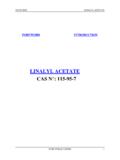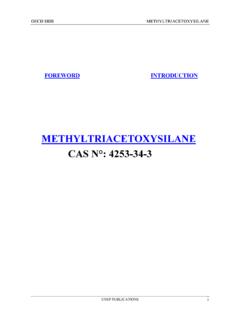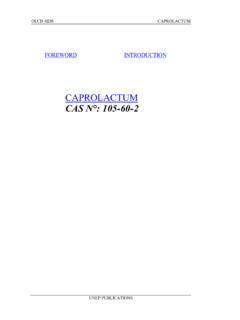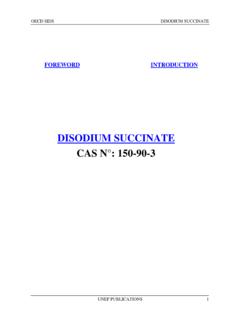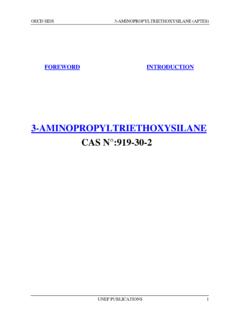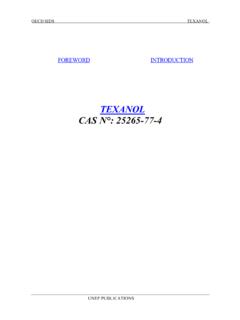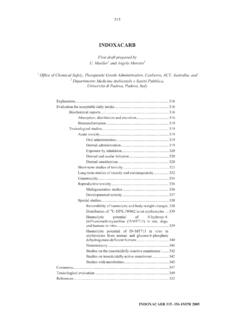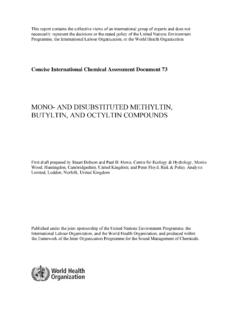Transcription of METHACRYLIC ACID CAS N°: 79-41-4 - inchem.org
1 OECD SIDSMETHACRYLICACIDUNEP PUBLICATIONSFOREWORDINTRODUCTIONMETHACRY LIC ACIDCAS N : 79-41-4 OECD sids METHACRYLIC ACID UNEP Publications 2 sids INITIAL ASSESSMENT PROFILE CAS Name METHACRYLIC acid Structural Formula CH2=CH(CH3)-COOHRECOMMENDATIONSThe chemical is a candidate for further work. SUMMARY CONCLUSIONS OF THE SIARH uman Health No relevant data are available concerning possible effects of METHACRYLIC acid (MAA) in humans. MAA is rapidly absorbed in rats after oral and inhalation administration.
2 The main clinical sign in animal tests on acute toxicity of MAA is severe irritancy at the site of contact. Oral LD 50 values of 1320-2260 mg/kg for rats, a dermal LD 50 value between 500 and 1000 mg/kg for rabbits and a LC 50 (rat) of mg/l/4h were determined. MAA causes adverse effects at the site of application, depending on the concentration and frequency or time of exposure. The undiluted acid causes skin and eye corrosion and respiratory tract lesions.
3 MAA is not sensitizing as demonstrated by human experience and by animal tests. The main effect of MAA in acute and subchronic animal studies is irritation/corrosivity at the site of contact. In repeated dose inhalation studies the relevant toxic effect was irritation of the nasal mucosa. Rhinitis was observed in rats >20 ppm ( mg/m ) and mice at 300 ppm (1071 mg/m ) when animals were exposed on 90 days. Additionally, in mice degenerative lesions of the olfactory epithelium occurred at doses from 100 ppm (357 mg/m ).
4 A NOAEL for the local effects of 20 ppm ( mg/m ) was derived from a study on mice. The NOAEC for systemic toxic effects was identified to be 100 ppm in mice and 300 ppm in rats. Toxic effects after dermal or oral application routes are is negative in a bacterial gene mutation test. Taking into consideration the data on the methyl ester of MAA (methyl methacrylate, MMA) - which indicate that MMA does not express a genotoxic potential in vivo - there is no need for further testing of MAA.
5 No cancer studies on MAA are available. Focal hyperplasia of the respiratory epithelium or lymphatic hyperplasia of mandibular lymph nodes in a 90-day inhalation study were not interpreted as a preneoplastic lesion but considered to represent reactive or inflammatory processes due to the irritant effect of MAA. With respect to MMA data, there is no concern on carcinogenic properties of MAA. Data on reproductive toxicity of MAA in animals or humans does not exist.
6 From studies with MMA no concern in relation to reproductive toxicity of MAA has to be assumed. No specific human population at risk could be identified within the general sids METHACRYLIC ACID UNEP Publications 3 Environment Approximately 45 000 t/a of METHACRYLIC acid (MAA) are assumed to be available on the European market. MAA is used as an internal and external intermediate in the chemical industry for the production of METHACRYLIC acid esters and as a co-monomer in different kinds of polymers.
7 MAA has a water solubility of 89 g/l, a vapour pressure of hPa and a log Kow of According to the physico-chemical properties the target compartment for this substance is the is stable in neutral solution and is classified as "readily biodegradable". There is no considerable potential for bio- or geoaccumulation. An atmospheric half-life of 11 h was calculated for this substance. The following results from ecotoxicity tests with aquatic species are available: In a short-term test with fish a 96h LC50 of 85 mg/l was found for Oncorhynchus mykiss: For invertebrates acute and long-term studies on Daphnia magna had been conducted.
8 A 48h EC50between 100 and 180 mg/l and a 21d NOEC of 53 mg/l were found in these tests. The most sensitive environmental species to MAA is the alga Selenastrum capricornutum with a 72h EC50 of 45 mg/l and a 72h-EC10 of mg/l. Based on these data there is a moderate hazard concern to aquatic organisms. With an assessment factor of 50 a PNEC of 164 g/l is determined. For the production and processing of MAA and for the use of polymeric products made from MAA most of the estimated PECs are well below the PNEC and no further work is recommended.
9 However, from the use of a grouting agent containing hydroxyethyl-methacrylate high releases of MAA to the hydrosphere via drainage water were identified. Measured effluent concentrations up to 4 mg/l are reported for a specific tunnel construction site leading to local water concentrations up to 200 g/l. ExposureNo information. NATURE OF FURTHER WORK RECOMMENDEDE nvironmentThis substance has been agreed in the European Risk Assessment Program under Regulation EEC/793/93 with the following conclusion:A risk to the aquatic environment in the vicinity of a tunnel construction site was identified.
10 A quantitative extrapolation to other construction sites seems not possible but similar conditions can be anticipated. It is recommended to develop a risk reduction strategy to achieve an environmentally safe handling of the grouting agent. Human Health MAA is a respiratory tract irritant. There is a need for limiting the risks of respiratory tract irritation in several working areas (particularly in the industrial area without use of LEV). Risk Reduction Measures at the community level are recommended.
